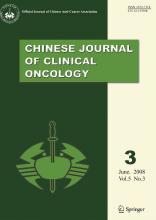keywords
Introduction
Angiosarcomas are rare highly malignant neoplasm that make up less than 2% of all soft-tissue sarcomas. Only 40 renal cases have been described[1]. Their origin is from endothelial cells. They are frequently hemorrhagic tumors, being able to simulate a retroperitoneal hematoma or cause massive hematuria[2,3]. We present a case of primary renal angiosarcoma and emphasize its hemorrhagic behavior.
Case Report
A 63 year old male patient, who had a left costal swelling and pain for 2 months, was admitted to our hospital. CT scanning showed that there was the presence of a lesion of a solid tumor mass at the middle and lower part of the left kidney, with a size of about 11 × 8.5 × 4.8 cm. The patient’s hemoglobin (HG) was 54 g/L on admission. Since he was suspected of having a rupture and hemorrhage of the kidney, a radical excision of the left kidney was conducted in the emergency room.
The size of left kidney was 13.5 × 10 × 5.7 cm. There was a tumor mass at the middle and lower portion of the left kidney, with a size of about 10 × 8 × 4.5 cm, and a sorrel, spongiform and soft cut surface. A charcoal grey hemorrhagic focus and necrosis could be seen in the center. There was a distinct boundary with the peripheral tissues, but the tumor was not an encapsulated (Fig.1A). Microscopic observation indicated that the tumor tissue was comprised of an irregular and mutually anastomotic lacuna of vessels, which were found between the collagen fiber bundles. The lumen of the blood vessels was multilamellar and covered with various pantomorphic and hyperchromatic endothelial cells. The tumor cells presented in a fusiform shape. The tumor cell nuclei had an obvious heteromorphism, and a dark-staining nuclear chromatin. Polykaryocytes could be seen, with sparse cytoplasm and apparent mitotic figures. Necrosis and hemorrhage were common (Fig.1B&C). Immunohistochemical results showed that vimentin and CD34 were positive and CK and EMA negative (Fig.1 D). Pathological diagnosis demonstrated an angiosarcoma of the left kidney, accompanied with hemorrhage and necrosis.
A, The cut surface of the tumor was sorrel and spongiform, with a distinct boundary to the peripheral tissues. B&C, The tumor tissue was comprised of irregular and mutually anastomotic lacuna of vessels. The lumen of the blood vessels was covered with various pantomorphic and hyperchromatic endothelial cells. The tumor cell nuclei had an obvious heteromorphism, with apparent mitotic figures, H&E stain × 200. D, Immunohistochemical analysis showed that vimentin and CD34 were positive, and CK and EMA negative. Envision method × 200.
Discussion
Angiosarcoma, originating from the kidney, is an infrequently-seen and invasive malignant tumor derived from endothelial cells. Since 1942, about 40 cases of primary renal angiosarcoma (PRA) have been reported in the world, however only 5 have been reported by authors in China[4]. The disease is commonly seen in elderly and middle-aged males, with a male-female ratio of 4.7:1, possibly related to androgen levels. The mean age of the patients is 59 years. The incidence of PRA of the left kidney is two times that of the right kidney, with a common site being in the vicinity of the renal capsule. Frequent clinical symptoms include hypochondrium pain (81%), bloody urine (38%), a palpable mass and weight loss (31%). Tumor spalls cause retroperitoneal hematomas, and apparent anemia occurs in the patients. The gross tumor volume may be as large as 5 cm or more in 90% of the cases.
Microscopic observations show a dark-red and ill-defined hemorrhagic tumor mass, and a spongiform surface with capillary lumens of a size similar to a hemangioma. In the well-differentiated area, there is primary luminal cavitation, and pantomorphic tumor cells can be seen in poorly differentiated regions. The primary focus and metastasis can be found by image analysis, but it is difficult to differentiate from a primary renal carcinoma or renal pelvic carcinoma. Therefore a final diagnosis will rely on a histological and immunohistochemical examination. CD31, CD34 and VIII anti-genes are positive in the vasoformation area of angiosarcoma, and CK is produced in some angiosarcomas. PRA is highly malignant, and the patients have a poor prognosis. Commonly the patients develop early hematogenous metastasis, and at diagnosis, approximately 1/3 of the patients are identified as having metastasis. Most of the patients die within 10 months after diagnosis. The 5-year survival rate was 32% for patients who had a tumor diameter of 5 cm, or less, and 13% for those having a tumor diameter greater than 5 cm[5]. Surgical resection is the preferred treatment method since radiotherapy and chemotherapy are not effective in these cases.
Footnotes
This work was supported by a grant from the Outstanding Youth Foundation of Jilin Provincial Scientific Development Program (No. 20060103).
- Received February 25, 2008.
- Accepted April 29, 2008.
- Copyright © 2008 by Tianjin Medical University Cancer Institute & Hospital and Springer












